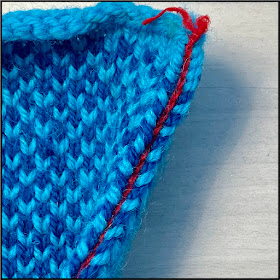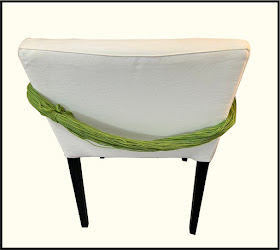Needle felting is a trick worked on dry fabric, which melds together woolen fiber. I say woolen because actual wool from the back of a living sheep really is the only fiber with with structure and body for this form of fabric-torture. And torture it is: as used in knitting, needle felting involves plunging very sharp barbed needles through fabric to draw wisps of the top layer down into the bottom layer. These wisps serve to bind the two layers together.
In the art of hand-knitting, needle felting is often associated with the trick of steeking (cutting) a fabric.
 |
| Needle-felted steek, cut and folded back |
It is also useful to hold floats from color-knitting onto the fabric-back.
 |
| Elephant with floats needle-felted to fabric back |
We'll get to these uses, and others as well, but first, the basics.
Felting needles and pad
There are several types of felting needles. All feature a wickedly sharp point atop a barbed shaft.
 |
| Close up of Clover brand needle felting tool needles. Click here to enlarge. |
The barbs are arranged so they catch wisps of wool on the downward stroke only. When withdrawn, the barbs do not catch any wisps. When one layer of woolen fabric is felted to another below, the downward-drawn wisps are permanently parked in the lower layer. These wisps are what hold (felt) the two fabrics together.
The safest way to use a felting tool is with a pad beneath. This may resemble a sponge or hairbrush. I find the hairbrush type more useful. Either way, the fabric to be felted is laid over the pad and the needles plunge through the fabric, then harmlessly into the pad rather than your fingers--less blood that way. Again, these needles are wicked sharp. They deserve the same respect as a sewing needle, or more, being barbed.
Felting needles are generally held in a pen- or knob-type holder, and you can usually select how many of the available holders to fill with needles. The felting pen above comes with three needles, as shown, but by unscrewing the case, you can choose to work with only one or two needles at a time.
Wool
Real wool from the back of a live sheep gives the best results. This is because of wool's scaly nature at the microscopic level.
 |
| Wool (left two images) compared with other fibers |
With wear and pressure, scales of wool catch on one another, almost like the hooks of velcro. Since even the thinnest wisps of wool are scaly like this, pushing a wisp from a top layer into a bottom layer "velcro's" the layers together. This micrograph comparison of wool to other fibers--especially the synthetic fiber at far right--shows that pushing wisps of non-wool fiber into one another would not have the same catching effect because these other fibers have few or no scales to catch together.
To further improve the "velcro" effect, steaming wool makes wool's scales open like a pine cone, causing further interlocking. So, needle felting through steamy fabric increases the effect, while steaming afterwards strengthens the bond between layers. Therefore, although needle felting is called a dry fabric technique (as opposed to its cousin, wet felting) a little water in the form of steam vapor really helps the process along. If you've tried needle felting before and haven't found much benefit, try again through a steamy fabric. There is a big difference.
Needle felting is really only speeding up a process which would happen naturally as scaly woolen fibers rub on one another. However! Rubbing operates at one time scale and metal barbs at another. It would take a LOT of rubbing to create the felting which needles produce in a short time. Overdoing needle felting on hand knits can felt the fibers enough to undo stitch definition, just as wet felting does. Super-overdoing can actually cut right through the fabric, especially on thinner yarns. Felting thin yarn takes a LOT less plunging than the worsted weight I used in the demos below. Bottom line: proceed slowly, practice on a swatch.
Needle felting steeks
 |
Two-color knitting, front (left) and back, slip stitched in red, with a cut-line marked in white yarn. |
Transcript. Here is the process of needle felting. This is the needle felter. And you see the (needle felting) pad below. You simply insert the needle felting tool into the fabric from the front, being careful to stay within the lines of the stabilization. You plunge the needle rapidly, back and forth through the fabric.
Transcript. Now we come the action shot of cutting the steek. I think it's very handy to have that white cutting line. If you look at the edge of the fabric, you can see how felted it is. And, here’s the inside. Even if I run my finger along here, no edges are coming loose. So this is a really solid and stable edge. A little bit of the fluff is coming out (including the cutting line!) but the edge itself is not disintegrating in any way.
 |
| The pick up line is shown on the front of the fabric, one half-column away from the stabilizing stitches. However, it could be located further. |
 |
| Left: pinned. Right: pins removed, steamed and then felted in place, the flap has formed a "self facing." The felted-down flap is called a "facing," because it provides a smooth face on the inside of a garment opening. It is a "self-facing" because the fabric itself was folded over to form the facing. This is in contrast to an "applied facing," meaning a separate fabric is knitted to act as the facing. |
Needle felting color knitting
Fastening Floats
In color knitting, the contrasting color or background yarn not in use runs along the back of the fabric in loose strands called "floats." A great deal of knitting ingenuity has been devoted to different methods for fastening floats--especially long floats--to the back fabric face. However, needle felting isn't usually considered in this context. This oversight is a pity because needle felting can hold floats in place. In fact, if you think about it, holding down the floats is exactly what needle felting is doing when cutting steeks in color knitting.
This video compares two little elephants.* The one at left features felted floats, on the other, the floats are not yet felted. The longest float is 14 stitches. There are also 12's, 10's, and 8's.
Transcript: This is the back of two little elephants. On this one (right), the floats are not felted down. I can easily insert the knitting needle under here, and if I stroke the back of the fabric, you can see that the floats are independent. These are some quite long floats: these are 14’s, this is a 12, these are 10’s and 8’s in here. On this side (left) the floats have been felted down. If I stroke the back of the (left) fabric, the floats don’t come up. They are attached, even this very long one here, this 14. And these 10’s. And this is the advantage of felting down long floats. If a kid put this little garment on, they wouldn’t catch their fingers and toes in it, like they would if this here (right, unfelted) was the finished product.
Flattening fabric
Here is a photo of the fronts after felting. Turned right-side out, the felted elephant is at right. Another advantage can now be seen: the contrasting color stitches of the felted elephant are much smoother against the background fabric than with the unfelted elephant at left. Felting has flattened the "fabric breaks," meaning, the little valleys along the edge of a linear color pattern where a column of cc stitches rises up just where the column of background stitches dives down. Compare particularly along the back columns, under the tails.
Felting has also flattened out the fabric overall. Compare, for example, the felted elephant's stomach to that of the unfelted. Both elephants have been steam blocked. Yet even so, the felted one lies smoother against the background stitches.
 |
| Right elephant has been flattened to the background fabric via needle felting. Click to enlarge |
Flattening out works just as well for that one contrast color stitch which just persists in sticking up. Perhaps the yarn got thicker just at that one spot, perhaps the tension went off. Needle felting will tame its stubborn little ways so its lays flat.
Correcting tension--loose floats
Loose floats make for bad tension. Needle felting can tighten up that occasional loose float. Working from the front while tugging at the loose loop on the back, adjust the tension until it looks correct. Then, flip the fabric over. Finally, pull each loop into a nearby column.
Below left: double-pointed needle inserts under two loose loops on the elephant's back. Center: crochet hook draws the loose bottom loop into a nearby column. Right:crochet hook draws the loose top loop into a nearby column.
Below left: knitting needles point to where the loops have been worked into the column. Right: the same column, lightly felted. Once felted, the loose loops meld into the column, never to come loose again.
Surface-felting
This is a trick for improving diagonal lines in color knitting. When knitting a diagonal, the stitches may not join into a smooth line. Often, the arm of the neighboring stitch gets in the way. Result: two same-color stitches don't meet on the kitty-corner.
Very delicate work with a single felting needle can solve this problem by surface-felting together the two stitches which ought to touch. Use a single needle to tease together a few wisps from each stitch in turn, until the stitches do join over the gap. This kind of touch-up especially helps make knitted alphabet letters more legible.
Close-up of the dark letter "O" before, during, and after surface felting over an intervening white stitch-arm. Red arrows locate the intervening white arm. Blue arrows show the path of a single felting needle passing through two dark kitty-corner stitches as it travels towards upper left. In the rightmost photo, the dark yarn is fuzzed over the gap. The diagonal is now continuous.
 |
Improving the letter "O" via needle felting. Left: gap in diagonal (red arrows). Center: inserting felting needle along fabric surface. Right: gap covered. (I also fuzzed the O's left corner somewhat.) |
And, speaking of alphabet letters, knitting letters and words is what the next post is about. (Warning--political!)
--TK
* Elephants adapted from a free Ravelry sock pattern designed by Jenny Lorefors.
































